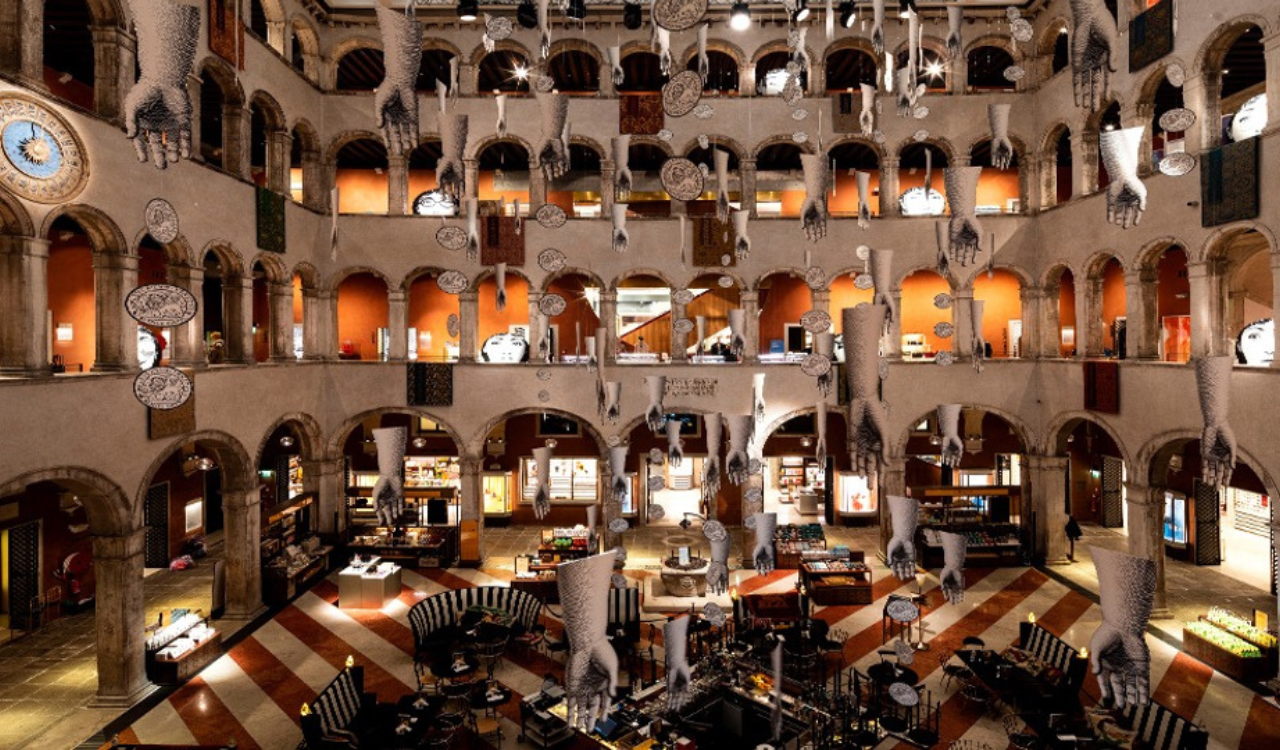What happened to the retail store experience? Fifty years ago, when entering this retail design profession, I was told that “Retail Is Theater.” Brick-and-mortar retail leaders need to ask themselves what business they are in: retailing, hospitality and entertainment, or a transactional relationship? And then they need to ask: Will I matter in five years? This industry needs to discover insights from outside its sector and explore the network of unique destinations that are uniquely merchandised, designed, and operated with a heavy dose of local wonder. The hospitality and entertainment industries figured this out a long time ago.
The Future of Experience
I was privileged to contribute to ‘The Future of Experience,’ The Sybarite Report 2025/26. Along with 18 top thought-leading thinkers and practitioners, we explored 45 retail stores that are not merely points of transaction but cultural landmarks: places where history, creativity, and community converge. Such destinations remind us that retail at its best is about discovery, theatre, and emotional connection—experiences that root themselves in memory and meaning long after the purchase has been made. Sybarite offers readers of The Robin Report a complimentary download of this thoughtful report via this link.
Collectively, we explored the conundrum that most retail offerings aren’t necessities, which begs the question: What makes them matter to consumers? The answer lies in identifying the elusive formula of relevance and meaning, not just in a product or object but in the narrative and the experience it offers. It’s about making the physical store a place of social relevance, where newness is always happening—meaningful, engaging, and worth one’s time and mental space. To order your free copy of The Future of Experience, register here.
In their quest for scale, many legacy retail brands have transitioned from curators of wonderment to experts in expansion and operational effectiveness. Public listings, expansion mandates, and cost-cutting initiatives can propel these operators into performance engines by managing expenses through operational effectiveness. The smart operators blend concept innovation with performance.
The Failure of Efficiencies
As we know, many old-world retailers — but not all — have lost their unique DNA that defined their relevance before they chose to pursue profit through scaling, mergers, and operational optimization. Granted, investing in innovation, newness, or potentially breakthrough experiences and marketing strategies can be intimidating and even risky. But it has become abundantly clear that managing old-world traditional retail formats through operational efficiencies and expense management is no longer enough to survive. It may delay the decline but not lead to organic growth in competing for market share against new retail formats worldwide. A gradual decline in market share or the hearts and minds of your core customers can be a side effect of operational “optimization” that prioritizes efficiency over the essence of what makes nonessential retail compelling.
In their quest for scale, many legacy retail brands have transitioned from curators of wonderment to experts in expansion and operational effectiveness. Public listings, expansion mandates, and cost-cutting initiatives can propel these operators into performance engines by managing expenses through operational effectiveness. The smart operators blend concept innovation with performance.
Efficiency and scalability are critical for growing conventional essential retail categories, but such uniformity is antithetical to the nonessential retail sector. The best in the industry have always been about aspiration, discovery, and establishing long-lasting emotional connections. When hard metrics become the industry bible, and the soft metrics become subordinate or disappear altogether, the soul of the store brand withers. In a world where most retailers sell merchandise that few need, and most everything is available at our fingertips 24/7, consumers are seeking reasons to visit, spend time, and shop in the built environment. Delivering endless aisles of sameness is not just uninspiring—it’s also discouraging to a customer with so many other options and choices.
Searching for Socially Relevant Retail
The most resonant, broadly defined retail, hospitality, and entertainment destinations today are those that curate and cultivate a complex balance between the offer, the delivery, the context of the place, and the combined experiences they create.
Consider the redesigned Tiffany New York flagship as an iconic experience. There are many other examples around the world across all types of retailing and hospitality brands that have this seductive blend of inspirational retail and entertainment. Look at Eataly and the Restoration Hardware flagships around the world. They have become destinations with restaurants, hotels and even yachts. Dick’s Sporting Goods House of Sports’ 100,000 square-foot centers celebrate sports and high performance. The Tin Building in New York is an iconic culinary experience. Le Bon Marché in Paris is a cultural and socially relevant retail experience. The Grove in Los Angeles is a pioneer in an outdoor mixed-use experience. And look at any Porsche driving center or dealership: you can grab a snack, have lunch or dinner, take a test drive with instructions, shop branded merchandise, and socialize with your brand tribe.
In Hollywood, the globally famous Hollywood Bowl, a 20,000-seat amphitheater, is a seamless combination of a pre-show experience that lasts two to three hours, featuring shopping, dining, and socializing, followed by a three-hour show. It is a socially relevant retail experience, capturing a share of time and heart and, therefore, a share of the wallet.
Think of Starbucks’ Reserve Roasteries as reimagined retail role models. They are not formulaic rollouts; each location is deeply embedded in local identity through design, product, or storytelling. It’s a reinvention of global branding—where branded destinations speak to the world at large yet feel unmistakably of their place.
Old World vs New World Consumerism.
There is an accelerating differentiation between transactional retailers (think Costco, Amazon, Alibaba in China, CVS), offering essential necessities, with those retailers competing for market share by selling nonessential discretionary merchandise, and for that matter, across all forms of entertainment and hospitality. This is precisely why examples of Old-World retailers are stalled, with the most obvious being the American department stores.
We cannot help but rue the demise of the American department store. It was once the ultimate curator of lifestyle and socially relevant, boasting a rich history of creativity that represented its unique sense of place. In their glory days, department stores represented the most defining and enduring retail values, cementing their relevance.
Many old-world retailers have also lost their commitment to their narrative, the story that binds together everything they do. The traditional retail industry’s preoccupation with sales per square foot overlooks a more meaningful metric: share of time—the actual currency of engagement. If people are not eating, sleeping, or working, they are likely spending time on various experiences. This is retail’s new playing field—not just selling goods but capturing minutes, hours, or even days and evoking emotions to create memories.
The Currency of Relevance
A significant way to remain relevant is in a store’s physical experience. Retailing is a fast-paced and ever-changing business. Brands, trends, merchandising schemes, and visual messaging are constantly evolving. Allowing a store to grow outdated over five to ten years sends a message of not caring, a lack of relevance and newness, and a retreat from the business. Refresh, rethink, renovate, and update on a continuous cycle.
Maintaining relevance and newness is not a seasonal proposition. It is an operating strategy. Keep the store physically compelling and programmatically alive. Bring people something they have not seen, felt, or thought about anywhere else. That is the foundation of share of mind—and ultimately, share of wallet.
Excellence Lives in the Details
Amidst the excitement around “experience,” we must not fall into the trap of meaningless design spectacles. True excellence is driven into every detail as a set of non-negotiable standards and executed with operational excellence; no detail is too small.
Transactions should be seamless. Fitting rooms should feel like personal sanctuaries. Cleanliness, sightlines, lighting, temperature, scent, music, world-class storytelling, and visual merchandising — these are not afterthoughts. They are a store’s unique signature.
Trained service and staff who have been instilled in the art of anticipation. While costly, these details deliver beyond expectations. They are fundamental necessities. Retailers often ask if such gestures “convert to sales.” But that is the wrong question. The right question is: “Did it matter? Did it connect? Did it build a reason to return?”
Creativity Is Connected
For nonessential retail to continue evolving, it must transcend its traditional playbook, drawing inspiration from best-in-class mixed-use villages, hospitality, cruise ships, food and beverage, and entertainment sectors. The Four Seasons model offers a powerful parallel. Each hotel reflects its setting—mountains in Chiang Mai, savannahs in Kenya, and beaches in St. Barts—while religiously maintaining standards that establish trust and exceed expectations on every visit. Staff are trained in the art of anticipation, not just service. This combination of consistency and surprise builds love, brands, and trust.
Too few retailers operate this way. But those who do—Hermès, Apple, RH, Le Bon Marché, and the Tiffany flagship—are not just surviving. They are leading because they understand that experience is not a campaign but a culture.
Leadership with Courage
An iconic architect once said, “It takes a great client to do great work.” The consulting industry can only take a client so far, borrowing from an abundance of other experts who expound upon and replay what’s new, who is doing what, why it matters, and how their thought leadership positions are the best and brightest. The role of the business strategist, retail and merchant consultant, designer, and architect is critically important as a catalyst to use the expert tools in the retailer’s toolbox. These alchemists facilitate the exploration and creation of uncompromising, discerning solutions that can be considered and implemented.
Ultimately, it requires an inspired leadership team, ownership, a board of directors, and developers to lead with a viable vision and a conviction to innovate in creating, regaining, and maintaining relevance. Courage is not a cliché; to matter, informed and inspired leadership is not a nice thing to have; it’s a requirement to survive.





